ASTM D 3577-09 橡胶医用手套标准规范
- 格式:pdf
- 大小:113.84 KB
- 文档页数:4
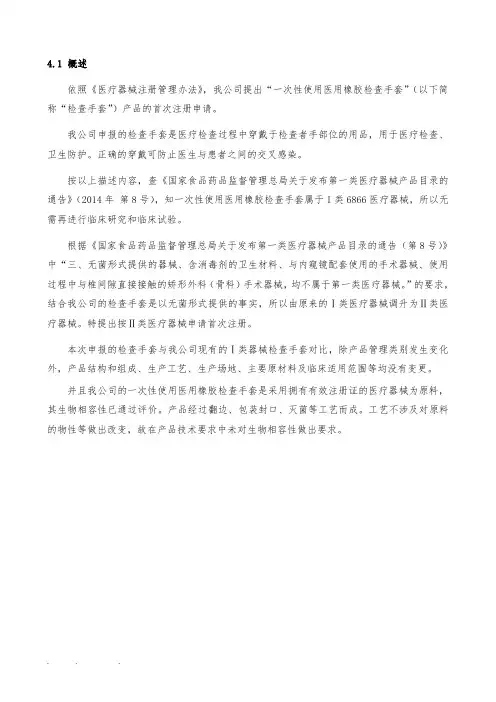
4.1 概述依照《医疗器械注册管理办法》,我公司提出“一次性使用医用橡胶检查手套”(以下简称“检查手套”)产品的首次注册申请。
我公司申报的检查手套是医疗检查过程中穿戴于检查者手部位的用品,用于医疗检查、卫生防护。
正确的穿戴可防止医生与患者之间的交叉感染。
按以上描述内容,查《国家食品药品监督管理总局关于发布第一类医疗器械产品目录的通告》(2014年第8号),知一次性使用医用橡胶检查手套属于I类6866医疗器械,所以无需再进行临床研究和临床试验。
根据《国家食品药品监督管理总局关于发布第一类医疗器械产品目录的通告(第8号)》中“三、无菌形式提供的器械、含消毒剂的卫生材料、与内窥镜配套使用的手术器械、使用过程中与椎间隙直接接触的矫形外科(骨科)手术器械,均不属于第一类医疗器械。
”的要求,结合我公司的检查手套是以无菌形式提供的事实,所以由原来的Ⅰ类医疗器械调升为Ⅱ类医疗器械。
特提出按Ⅱ类医疗器械申请首次注册。
本次申报的检查手套与我公司现有的Ⅰ类器械检查手套对比,除产品管理类别发生变化外,产品结构和组成、生产工艺、生产场地、主要原材料及临床适用范围等均没有变更。
并且我公司的一次性使用医用橡胶检查手套是采用拥有有效注册证的医疗器械为原料,其生物相容性已通过评价。
产品经过翻边、包装封口、灭菌等工艺而成。
工艺不涉及对原料的物性等做出改变,故在产品技术要求中未对生物相容性做出要求。
4.2 产品描述4.2.1 产品简介一次性使用医用橡胶检查手套提供给医护人员(医院的护士人员、防护人员以及医疗检查者)使用,医疗检查过程中穿戴于检查者手等部位的用品,用于防止检查者与患者之间的交叉感染。
产品用于医疗检查、卫生防护。
产品由天然橡胶胶乳制成。
产品原材料为外购,采购自取得一次性使用医用橡胶检查手套注册证的山东玉源乳胶手套有限公司,该公司能提供符合现行法律法规和标准的证明文件及生物学评价报告,通过了我公司的合格供方鉴定并已成功合作多年。
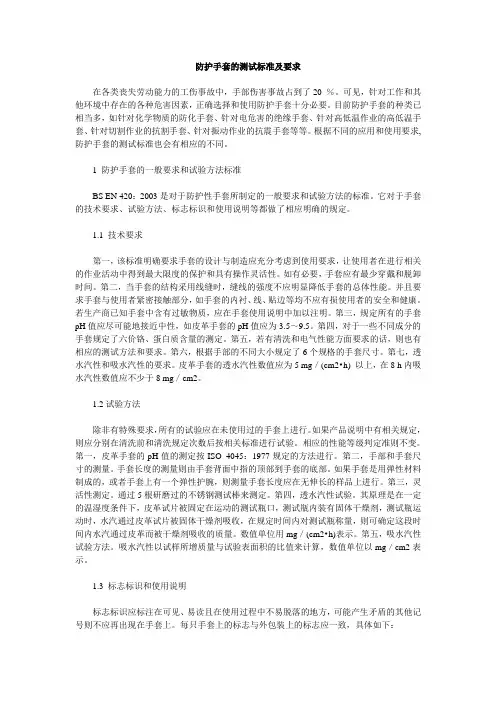
防护手套的测试标准及要求在各类丧失劳动能力的工伤事故中,手部伤害事故占到了20 %。
可见,针对工作和其他环境中存在的各种危害因素,正确选择和使用防护手套十分必要。
目前防护手套的种类已相当多,如针对化学物质的防化手套、针对电危害的绝缘手套、针对高低温作业的高低温手套、针对切割作业的抗割手套、针对振动作业的抗震手套等等。
根据不同的应用和使用要求,防护手套的测试标准也会有相应的不同。
1 防护手套的一般要求和试验方法标准BS EN 420:2003是对于防护性手套所制定的一般要求和试验方法的标准。
它对于手套的技术要求、试验方法、标志标识和使用说明等都做了相应明确的规定。
1.1 技术要求第一,该标准明确要求手套的设计与制造应充分考虑到使用要求,让使用者在进行相关的作业活动中得到最大限度的保护和具有操作灵活性。
如有必要,手套应有最少穿戴和脱卸时间。
第二,当手套的结构采用线缝时,缝线的强度不应明显降低手套的总体性能。
并且要求手套与使用者紧密接触部分,如手套的内衬、线、贴边等均不应有损使用者的安全和健康。
若生产商已知手套中含有过敏物质,应在手套使用说明中加以注明。
第三,规定所有的手套pH值应尽可能地接近中性,如皮革手套的pH值应为3.5~9.5。
第四,对于一些不同成分的手套规定了六价铬、蛋白质含量的测定。
第五,若有清洗和电气性能方面要求的话,则也有相应的测试方法和要求。
第六,根据手部的不同大小规定了6个规格的手套尺寸。
第七,透水汽性和吸水汽性的要求。
皮革手套的透水汽性数值应为5 mg/(cm2•h) 以上,在8 h内吸水汽性数值应不少于8 mg/cm2。
1.2试验方法除非有特殊要求,所有的试验应在未使用过的手套上进行。
如果产品说明中有相关规定,则应分别在清洗前和清洗规定次数后按相关标准进行试验。
相应的性能等级判定准则不变。
第一,皮革手套的pH值的测定按ISO 4045:1977规定的方法进行。
第二,手部和手套尺寸的测量。
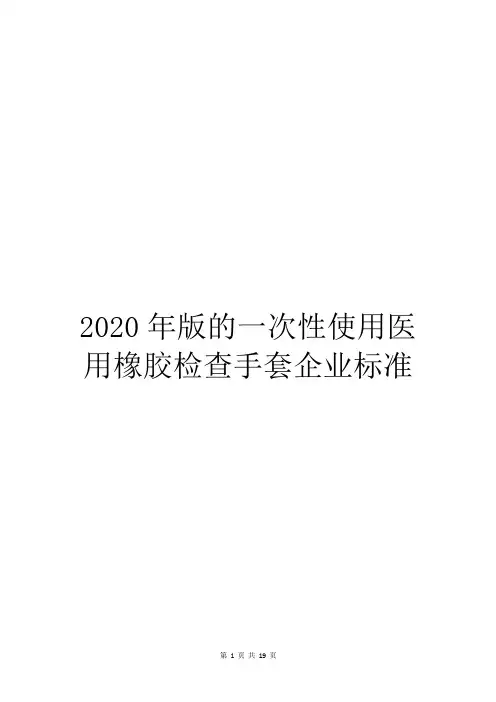
2020年版的一次性使用医用橡胶检查手套企业标准标准号:JHQB028-2020 备案号:JZJQ02021-2020JH/QB 新会嘉珩日用品有限公司企业标准医用外科口罩2020年4月16日发布 2020年4月17日实施新会嘉珩日用品有限公司发布前言本标准依据GB/T 1.1-2020《标准化工作导则第1部分:标准的结构和编写规则》起草。
本标准由新会嘉珩日用品有限公司提出并起草。
本标准主要起草人:李嘉珩。
本标准于2020年4月16日首次发布。
医用防护口罩1.目的为了保障本公司生产的一次性使用医用橡胶检查手套符合其安全指标及其要求,满足客户的需求,特制定本标准规范一次性使用医用橡胶检查手套的检验技术和方法。
2.范围本标准规定了一次性使用医用橡胶检查手套的术语和定义、原料、场地条件、工艺流程、产品分级、技术要求、试验方法、检验规则、包装、标志、贮存和运输等内容。
3 范性引用文件下列文件对于本文件的应用是必不可少的。
凡是注日期的引用文件,仅所注日期的版本适用于本文件。
凡是不注日期的引用文件,其最新版本(包括所有的修改单)适用于本文件。
GB/T 2828. 1 计数抽样检验程序第1 部分:按接收质量限C AQL) 检索的逐批检验抽样计划(GB/T 2828. 1—2003 , ISO 2859-1,1999,IDT)YY 0466 用千医疗器械标签、标记和提供信息的符号GB 10213-2006 一次性使用医用橡胶检查手套ISO 37 硫化橡胶或热塑性橡胶拉伸应力应变性能的测定ISO 188 硫化橡胶或热塑性橡胶热空气加速老化和耐热试验ISO 4648 硫化橡胶或热塑性橡胶试验用试样和制品尺寸的测定ISO 10993( 所有部分)医疗器械的生物学评价分类4.一次性使用医用橡胶检查手套技术要求4.1 总则手套按类别、表面型式分类,见 3. 2和 3. 3。
4.2 类别分为两个类别:4.2.1.类别 1 :主要由天然橡胶胶乳制造的手套;4.2.2.类别2:主要由丁腊橡胶胶乳、氯丁橡胶胶乳、丁苯橡胶溶液、丁苯橡胶乳液或热塑性弹性溶液制造的手套。
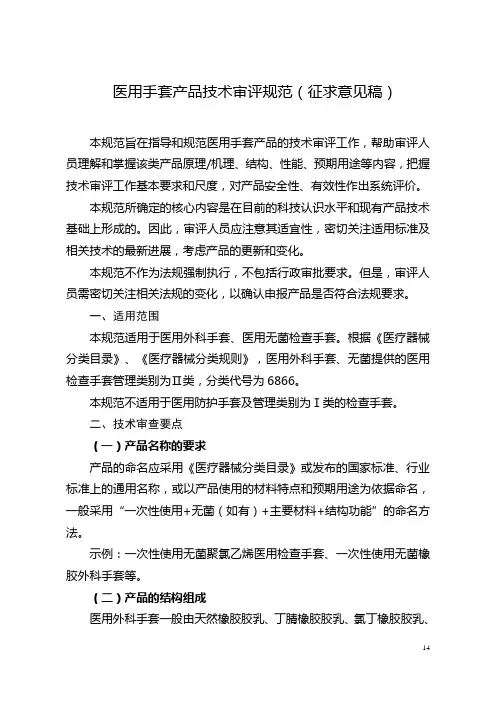
医用手套产品技术审评规范(征求意见稿)本规范旨在指导和规范医用手套产品的技术审评工作,帮助审评人员理解和掌握该类产品原理/机理、结构、性能、预期用途等内容,把握技术审评工作基本要求和尺度,对产品安全性、有效性作出系统评价。
本规范所确定的核心内容是在目前的科技认识水平和现有产品技术基础上形成的。
因此,审评人员应注意其适宜性,密切关注适用标准及相关技术的最新进展,考虑产品的更新和变化。
本规范不作为法规强制执行,不包括行政审批要求。
但是,审评人员需密切关注相关法规的变化,以确认申报产品是否符合法规要求。
一、适用范围本规范适用于医用外科手套、医用无菌检查手套。
根据《医疗器械分类目录》、《医疗器械分类规则》,医用外科手套、无菌提供的医用检查手套管理类别为Ⅱ类,分类代号为6866。
本规范不适用于医用防护手套及管理类别为Ⅰ类的检查手套。
二、技术审查要点(一)产品名称的要求产品的命名应采用《医疗器械分类目录》或发布的国家标准、行业标准上的通用名称,或以产品使用的材料特点和预期用途为依据命名,一般采用“一次性使用+无菌(如有)+主要材料+结构功能”的命名方法。
示例:一次性使用无菌聚氯乙烯医用检查手套、一次性使用无菌橡胶外科手套等。
(二)产品的结构组成医用外科手套一般由天然橡胶胶乳、丁腈橡胶胶乳、氯丁橡胶胶乳、丁苯橡胶或热塑性弹性体溶液或乳液、丁苯橡胶乳液等材料制成。
医用无菌检查手套一般由天然橡胶胶乳、丁腈橡胶胶乳、氯丁橡胶胶乳、丁苯橡胶或热塑性弹性体溶液或乳液、丁苯橡胶乳液、聚氯乙烯、聚乙烯等材料制成。
医用手套按照橡胶类型、设计、表面型式进行分类,一般有以下几种形式:按橡胶类型可以分为1型、2型、3型。
如:橡胶外科手套,1型指由天然橡胶胶乳制造的手套;2型是由丁腈橡胶胶乳、氯丁橡胶胶乳、丁苯橡胶溶液或乳液、热塑性弹性体溶液或乳液制造的手套;由1型和2型的材料混合或复合制造的手套为3型手套。
按设计样式可以分为:直型(R型)、弯型(C型)。
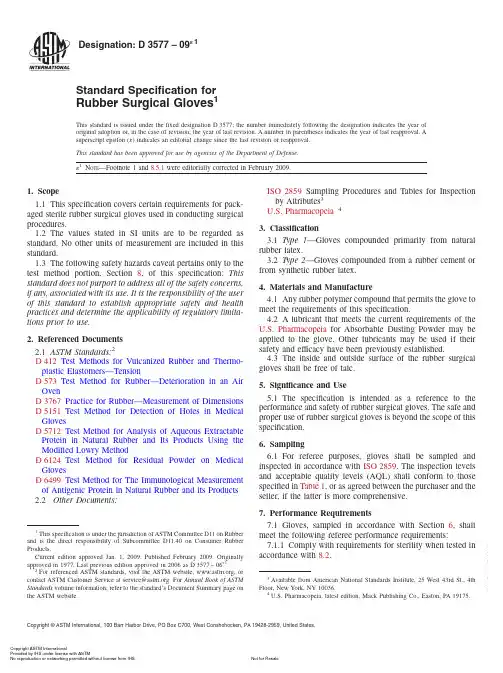
Designation:D3577–09´1Standard Specification forRubber Surgical Gloves1This standard is issued under thefixed designation D3577;the number immediately following the designation indicates the year of original adoption or,in the case of revision,the year of last revision.A number in parentheses indicates the year of last reapproval.A superscript epsilon(´)indicates an editorial change since the last revision or reapproval.This standard has been approved for use by agencies of the Department of Defense.´1N OTE—Footnote1and8.5.1were editorially corrected in February2009.1.Scope1.1This specification covers certain requirements for pack-aged sterile rubber surgical gloves used in conducting surgical procedures.1.2The values stated in SI units are to be regarded as standard.No other units of measurement are included in this standard.1.3The following safety hazards caveat pertains only to the test method portion,Section8,of this specification:This standard does not purport to address all of the safety concerns, if any,associated with its use.It is the responsibility of the user of this standard to establish appropriate safety and health practices and determine the applicability of regulatory limita-tions prior to use.2.Referenced Documents2.1ASTM Standards:2D412Test Methods for Vulcanized Rubber and Thermo-plastic Elastomers—TensionD573Test Method for Rubber—Deterioration in an Air OvenD3767Practice for Rubber—Measurement of Dimensions D5151Test Method for Detection of Holes in Medical GlovesD5712Test Method for Analysis of Aqueous Extractable Protein in Natural Rubber and Its Products Using the Modified Lowry MethodD6124Test Method for Residual Powder on Medical GlovesD6499Test Method for The Immunological Measurement of Antigenic Protein in Natural Rubber and its Products 2.2Other Documents:ISO2859Sampling Procedures and Tables for Inspection by Attributes3U.S.Pharmacopeia43.Classification3.1Type1—Gloves compounded primarily from natural rubber latex.3.2Type2—Gloves compounded from a rubber cement or from synthetic rubber latex.4.Materials and Manufacture4.1Any rubber polymer compound that permits the glove to meet the requirements of this specification.4.2A lubricant that meets the current requirements of the U.S.Pharmacopeia for Absorbable Dusting Powder may be applied to the glove.Other lubricants may be used if their safety and efficacy have been previously established.4.3The inside and outside surface of the rubber surgical gloves shall be free of talc.5.Significance and Use5.1The specification is intended as a reference to the performance and safety of rubber surgical gloves.The safe and proper use of rubber surgical gloves is beyond the scope of this specification.6.Sampling6.1For referee purposes,gloves shall be sampled and inspected in accordance with ISO2859.The inspection levels and acceptable quality levels(AQL)shall conform to those specified in Table1,or as agreed between the purchaser and the seller,if the latter is more comprehensive.7.Performance Requirements7.1Gloves,sampled in accordance with Section6,shall meet the following referee performance requirements:7.1.1Comply with requirements for sterility when tested in accordance with8.2.1This specification is under the jurisdiction of ASTM Committee D11on Rubber and is the direct responsibility of Subcommittee D11.40on Consumer Rubber Products.Current edition approved Jan.1,2009.Published February2009.Originally approved st previous edition approved in2006as D3577–06´1.2For referenced ASTM standards,visit the ASTM website,,orcontact ASTM Customer Service at service@.For Annual Book of ASTM Standards volume information,refer to the standard’s Document Summary page on the ASTM website.3Available from American National Standards Institute,25West43rd St.,4th Floor,New York,NY10036.4U.S.Pharmacopeia,latest edition,Mack Publishing Co.,Easton,PA19175.Copyright©ASTM International,100Barr Harbor Drive,PO Box C700,West Conshohocken,PA19428-2959,United States.--` , , ` ` ` , , , , ` ` ` ` -` -` , , ` , , ` , ` , , ` ---7.1.2Be free from holes when tested in accordance with8.3.7.1.3Have consistent physical dimensions in accordance with8.4.7.1.4Have acceptable physical property characteristics in accordance with8.5.7.1.5Have a powder residue limit of2.0mg in accordance with8.6.7.1.6Have a recommended aqueous soluble protein content limit of200µg/dm2in accordance with8.7and Annex A1or have a recommended antigenic protein content limit of10µg/dm2in accordance with8.9and Annex A2.7.1.7Have a recommended maximum powder limit of15 mg/dm2in accordance with8.8.8.Referee Test Methods8.1The following tests shall be conducted to assure the requirements of Section7as prescribed in Table1:8.2Sterility Test—Testing for sterility shall be conducted in accordance with the latest edition of the U.S.Pharmacopeia.8.3Freedom from Holes—Testing for freedom from holes shall be conducted in accordance with Test Method D5151.8.4Physical Dimensions Test:8.4.1The gloves shall comply with the dimension require-ments specified in Table2.8.4.2The length shall be expressed in millimetres as mea-sured from the tip of the secondfinger to the outside edge of the cuff.8.4.3The width of the palm shall be expressed in millime-tres as measured at a level between the base of the indexfinger and the base of the thumb.Values of width per size other than listed shall meet the stated tolerance specified in Table2.8.4.4The minimum thickness shall be expressed in milli-metres as specified in Table2when using a dial micrometer described in Practice D3767and in the locations indicated on Fig.1.For referee tests,cutting the glove is necessary to obtain single-thickness measurements.8.4.5Precision and Bias—The precision and bias of mea-suring glove dimensions are as specified in Practice D3767.8.5Physical Requirements Test:8.5.1Before and after accelerated aging,the gloves shall conform to the physical requirements specified in Table3. Tests shall be conducted in accordance with Test Methods D412.Die C is recommended.8.5.2Accelerated aging tests shall be conducted in accor-dance with Test Method D573.Test the gloves by either one of the following methods:8.5.2.1After being subjected to a temperature of7062°C for16662h,the tensile strength and ultimate elongation shall not be less than the values specified in Table3.This method shall be the condition for referee tests.8.5.2.2After being subjected to a temperature of10062°C for2260.3h,the tensile strength and ultimate elongation shall not be less than the values specified in Table3.8.5.3Precision and Bias—The precision and bias of deter-mining tensile strength and ultimate elongation of gloves are as specified in Test Methods D412.8.6Powder Free Gloves:8.6.1Determine the powder residue using Test Method D6124.8.7Aqueous Extractable Protein Content:8.7.1Determine the aqueous extractable protein(µg/mL) using Test Method D5712for each glove sample tested.8.7.2Determine the totalµg of aqueous extractable protein in each glove sample by multiplying the result from8.7.1by the total volume of extractant used for that specific glove sample.If the glove sample is less than a whole glove,then adjust the protein results to reflect the amount of protein in the whole glove.8.7.3Determine the square decimetres for the glove size. Multiply the minimum length and nominal width found in Table2and convert to dm2using(dm2/mm2)(mm2/10000). Four(4)is the factor for all inside and outside surface areas.8.7.4Determine the aqueous extractable protein content of a glove sample by dividing the result from8.7.2(totalµg of protein)by8.7.3(total surface area of glove).TABLE1Performance RequirementsCharacteristic Related Defects InspectionLevelAQLSterility fails sterility A N/A Freedom from holes holes I 1.5 Physical dimensions length,width,andthicknessS-2 4.0Physical properties before aging,after accel-erated agingS-2 4.0 Powder Free Residue Exceeds Maximum Limit N=5N/A Protein Content Exceeds RecommendedMaximum LimitN=3N/APowder Amount Exceeds RecommendedMaximum LimitN=2N/AAntigenic Protein Content Exceeds RecommendedMaximum LimitN=1N/AA See U.S.Pharmacopeia.TABLE2Dimensions and Tolerances8.7.5If the sample is more than one (1)glove,use theaverage µg/dm 2of protein for the number of gloves tested in the sample.8.8Powdered Gloves :8.8.1Determine the recommended maximum powder limit using Test Method D 6124for powdered gloves.8.8.2Determine the square decimeters for the glove size as in 8.7.3.8.9Antigenic Protein Content :8.9.1Determine the extractable antigenic protein (µg/mL)using Test Method D 6499for each glove sample tested.8.9.2Determine the total microgram of extractable anti-genic protein in each glove sample by multiplying the result from 8.9.1by the total volume of extractant used for that specific glove sample.8.9.3Determine the square decimeter for the glove size as in 8.7.3.8.9.4Determine the extractable antigenic protein content of a glove sample by dividing the result from 8.9.2(total microgram of antigenic protein)by 8.9.3(total surface area of glove).9.Acceptance9.1Gloves will be considered to meet the referee perfor-mance requirements when test results conform to the require-ments prescribed in Table 1.9.2Retests or reinspections are permissible under the pro-visions of the U.S.Pharmacopeia and ISO 2859.10.Packaging and Package Marking10.1Packaging —Packaging shall be provided to maintain sterility after sterilization during shipping and storage and permit opening without contamination of the gloves.10.2Marking:FIG.1Location of Thickness MeasurementsTABLE 3Physical RequirementsType Before Aging After Accelerated AgingTensile Strength Ultimate Elongation Stress at 500%Elongation Tensile Strength Ultimate Elongation I 24MPa,min 750%min 5.5MPa,max 18MPa,min 560%min II17MPa,min650%min7.0MPa,max12MPa,min490%min--`,,```,,,,````-`-`,,`,,`,`,,`---10.2.1Gloves shall have an appropriate marking or be color-coded to designate size.10.2.2Inner wrappers or wallets,if used,shall bear a size marking to be located on the outside of the wallet or wrapper.10.2.3Packages shall bear markings for the contents to include the glove size,instructions for opening,the legend “sterile,”and a manufacturing lot number.10.2.4The outermost case shall be labeled on one or more end panels with the glove size,the legend“sterile,”and a manufacturing lot number.10.2.5All levels of packaging shall conform to all appro-priate government labeling regulations.11.Keywords11.1gloves;rubber;surgicalANNEXES (Mandatory Information) A1.PROTEIN CONTENTA1.1The current assay precision is large enough that only a recommended limit can be considered.A1.2Consideration should be given to the relative repeat-ability and reproducibility when reporting test method results.A1.3Reasonable allowance should be given for test results in excess of the recommended limit until greater precision of the method can be attained.A2.ANTIGENIC PROTEIN CONTENTA2.1The current assay precision is large enough that only a recommended limit can be considered.A2.2Consideration should be given to the relative repeat-ability and reproducibility when reporting test method results.A2.3A pooled sample from three individual NR specimens or products as extracted in Test Method D5712is permitted for use as the extraction sample.ASTM International takes no position respecting the validity of any patent rights asserted in connection with any item mentioned in this ers of this standard are expressly advised that determination of the validity of any such patent rights,and the risk of infringement of such rights,are entirely their own responsibility.This standard is subject to revision at any time by the responsible technical committee and must be reviewed everyfive years and if not revised,either reapproved or withdrawn.Your comments are invited either for revision of this standard or for additional standards and should be addressed to ASTM International Headquarters.Your comments will receive careful consideration at a meeting of the responsible technical committee,which you may attend.If you feel that your comments have not received a fair hearing you should make your views known to the ASTM Committee on Standards,at the address shown below.This standard is copyrighted by ASTM International,100Barr Harbor Drive,PO Box C700,West Conshohocken,PA19428-2959, United States.Individual reprints(single or multiple copies)of this standard may be obtained by contacting ASTM at the above address or at610-832-9585(phone),610-832-9555(fax),or service@(e-mail);or through the ASTM website().--`,,```,,,,````-`-`,,`,,`,`,,`---。
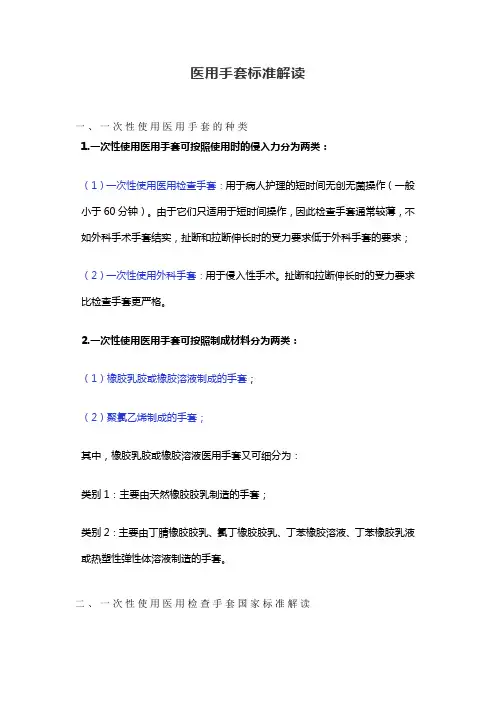
医用手套标准解读一、一次性使用医用手套的种类1.一次性使用医用手套可按照使用时的侵入力分为两类:(1)一次性使用医用检查手套:用于病人护理的短时间无创无菌操作(一般小于60分钟)。
由于它们只适用于短时间操作,因此检查手套通常较薄,不如外科手术手套结实,扯断和拉断伸长时的受力要求低于外科手套的要求;(2)一次性使用外科手套:用于侵入性手术。
扯断和拉断伸长时的受力要求比检查手套更严格。
2.一次性使用医用手套可按照制成材料分为两类:(1)橡胶乳胶或橡胶溶液制成的手套;(2)聚氯乙烯制成的手套;其中,橡胶乳胶或橡胶溶液医用手套又可细分为:类别1:主要由天然橡胶胶乳制造的手套;类别2:主要由丁腈橡胶胶乳、氯丁橡胶胶乳、丁苯橡胶溶液、丁苯橡胶乳液或热塑性弹性体溶液制造的手套。
二、一次性使用医用检查手套国家标准解读GB 10213-2006 《一次性使用医用橡胶检查手套》和GB 24786-2009 《一次性使用聚氯乙烯医用检查手套》分别规定了灭菌或非灭菌的、作为医用检查和诊断治疗过程中防止病人和使用者之间交叉感染的橡胶检查手套及聚氯乙烯医用检查手套的相关要求,也包括用于处理受污染医疗材料检查手套的性能、安全性和技术要求。
1.分类一次性使用医用橡胶检查手套分为主要由天然橡胶胶乳制造的手套及主要由丁腈橡胶胶乳、氯丁橡胶胶乳、丁苯橡胶溶液、丁苯橡胶乳液或热塑性弹性体溶液制造的手套两个材料类别。
分麻面、光面、有粉表面、无粉表面四种表面型式。
一次性使用聚氯乙烯医用检查手套分为部分或全麻面手套、光面手套、有粉手套、无粉手套四种类型。
其中,有粉手套是在手套的加工过程中加入粉剂,通常为了便于穿戴。
无粉手套在手套制造过程中没有另外加入粉末材料来便于穿戴。
无粉手套也可以用“非有粉”、“无粉”、“不加粉”或其他类似的词表示。
2.材料要求GB 10213-2006规定一次性使用医用橡胶检查手套应由配合天然橡胶胶乳、配合丁腈橡胶胶乳、配合丁苯橡胶或热塑性弹性体溶液或配合丁苯橡胶乳液制成。
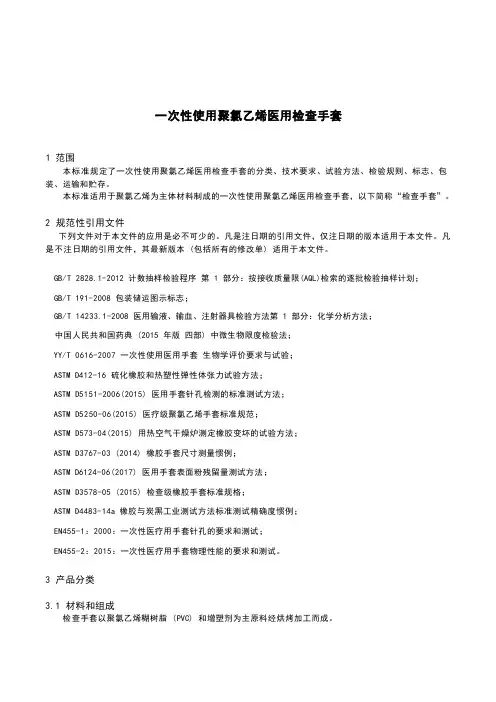
1 范围本标准规定了一次性使用聚氯乙烯医用检查手套的分类、技术要求、试验方法、检验规则、标志、包装、运输和贮存。
本标准适用于聚氯乙烯为主体材料制成的一次性使用聚氯乙烯医用检查手套,以下简称“检查手套”。
2 规范性引用文件下列文件对于本文件的应用是必不可少的。
凡是注日期的引用文件,仅注日期的版本适用于本文件。
凡是不注日期的引用文件,其最新版本 (包括所有的修改单) 适用于本文件。
GB/T 2828.1-2012 计数抽样检验程序第 1 部分:按接收质量限(AQL)检索的逐批检验抽样计划;GB/T 191-2008 包装储运图示标志;GB/T 14233.1-2008 医用输液、输血、注射器具检验方法第 1 部分:化学分析方法;中国人民共和国药典 (2015 年版四部) 中微生物限度检验法;YY/T 0616-2007 一次性使用医用手套生物学评价要求与试验;ASTM D412-16 硫化橡胶和热塑性弹性体张力试验方法;ASTM D5151-2006(2015) 医用手套针孔检测的标准测试方法;ASTM D5250-06(2015) 医疗级聚氯乙烯手套标准规范;ASTM D573-04(2015) 用热空气干燥炉测定橡胶变坏的试验方法;ASTM D3767-03 (2014) 橡胶手套尺寸测量惯例;ASTM D6124-06(2017) 医用手套表面粉残留量测试方法;ASTM D3578-05 (2015) 检查级橡胶手套标准规格;ASTM D4483-14a 橡胶与炭黑工业测试方法标准测试精确度惯例;EN455-1:2000:一次性医疗用手套针孔的要求和测试;EN455-2:2015:一次性医疗用手套物理性能的要求和测试。
3 产品分类3.1 材料和组成检查手套以聚氯乙烯糊树脂 (PVC) 和增塑剂为主原料经烘烤加工而成。
3.2 分类3.2.1 按灭菌与未灭菌分为灭菌和非灭菌产品。
3.2.2 按颜色不同分为自然色和彩色两类。
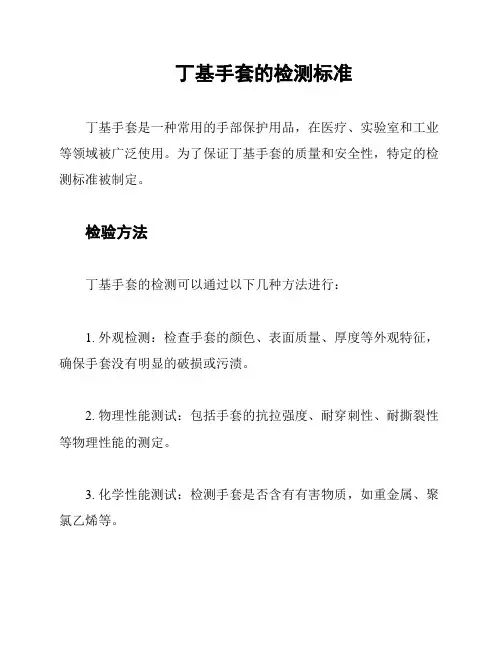
丁基手套的检测标准
丁基手套是一种常用的手部保护用品,在医疗、实验室和工业等领域被广泛使用。
为了保证丁基手套的质量和安全性,特定的检测标准被制定。
检验方法
丁基手套的检测可以通过以下几种方法进行:
1. 外观检测:检查手套的颜色、表面质量、厚度等外观特征,确保手套没有明显的破损或污渍。
2. 物理性能测试:包括手套的抗拉强度、耐穿刺性、耐撕裂性等物理性能的测定。
3. 化学性能测试:检测手套是否含有有害物质,如重金属、聚氯乙烯等。
4. 生物相容性测试:检测手套与人体接触是否引起过敏反应,并确保手套材料对皮肤无刺激。
检测标准
丁基手套的检测标准主要包括以下几个方面:
1. 国家标准:根据中国国家标准化管理委员会发布的相关标准进行检测,如《医用橡胶手套》(GB-2009)。
2. 行业标准:不同行业对丁基手套的要求会有所不同,可以参考行业协会或机构发布的标准,如医疗行业的《一次性医用手套》(YY/T 0698-2013)。
3. 国际标准:如果丁基手套用于出口或需要符合国际要求,可以参考国际标准,如美国FDA标准、欧洲EN标准等。
4. 企业标准:根据企业内部的品质管理要求和产品特性,制定适用于自身产品的检测标准。
检测结果与评价
进行丁基手套的检测后,根据检测结果进行评价。
如果手套符合相关标准,可以确认手套的质量和安全性,可以继续使用或投放市场。
如果手套不符合标准,则需要进行进一步的改进和调整,直至达到标准要求为止。
特别注意,本文所提到的检测标准仅为示例,具体的检测标准应根据实际情况和需求做出具体选择。
以上就是丁基手套的检测标准的一些基本内容,希望对您有所帮助。
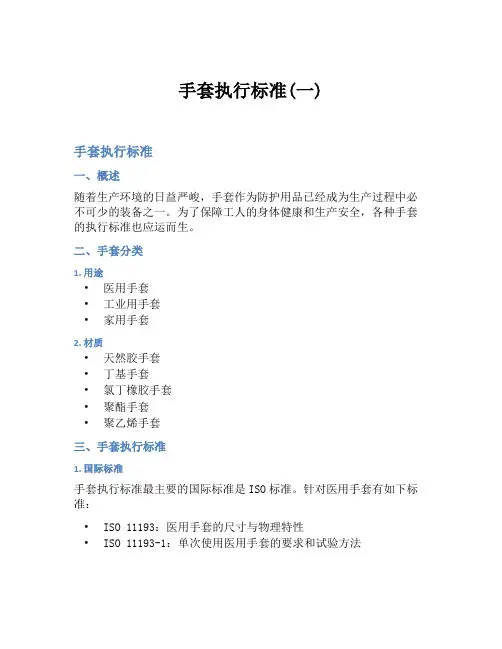
手套执行标准(一)手套执行标准一、概述随着生产环境的日益严峻,手套作为防护用品已经成为生产过程中必不可少的装备之一。
为了保障工人的身体健康和生产安全,各种手套的执行标准也应运而生。
二、手套分类1. 用途•医用手套•工业用手套•家用手套2. 材质•天然胶手套•丁基手套•氯丁橡胶手套•聚酯手套•聚乙烯手套三、手套执行标准1. 国际标准手套执行标准最主要的国际标准是ISO标准。
针对医用手套有如下标准:•ISO 11193:医用手套的尺寸与物理特性•ISO 11193-1:单次使用医用手套的要求和试验方法2. 国内标准国内医用手套执行标准有如下:•YY/T0698:单次使用乳胶检验手套•YY/T0700:单次使用丁腈检验手套•YY/T0699:手术手套3. 工业用手套标准工业用手套的标准除以上述ISO标准外,还有EN388标准等。
四、手套的正确使用方法手套的正确使用方法是保障工人健康的关键。
以下是手套的正确使用方法:1.在戴手套之前应洗手2.洗完手后应擦干并穿上手套3.手套与手指尖或物品接触时应尽量避免捏皱、撕裂等影响手套质量的行为4.工作完毕后应将手套脱下,并彻底清洗干净。
5.在清洗手套时,需使用套上手套的手来搓擦手套,以达到彻底清洗的效果。
五、结语手套作为防护用品,其执行标准和正确使用方法是保障工人的身体健康和生产安全的重要保障措施。
在生产实践中,我们要严格按照标准和方法使用手套,以保证生产的顺利进行和每一个工人的身体健康。
六、常见问题解答1. 手套使用过程中应注意哪些问题?在使用手套时,需要注意以下问题:•手套应先试穿,确认适宜度后再开始作业。
•手套在使用过程中应避免使用酸碱、有机溶剂和有毒物质,以及高温等特殊情况下。
•手套应定期更换,建议每日更换。
2. 手套正确清洗方式有哪些?手套在使用过程中应定期清洗,清洗方式如下:•洗手:戴上手套前应先洗手。
•不同种类的手套清洗方法不同,应按照手套说明书的要求进行清洗,若无说明可以选择用清水或中性清洗剂搓洗。
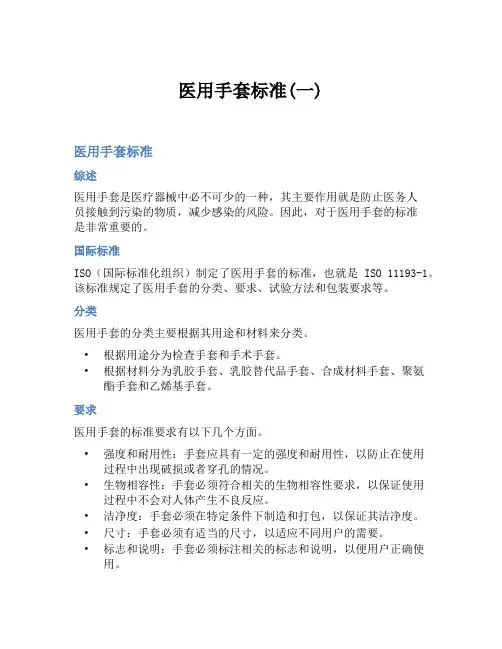
医用手套标准(一)医用手套标准综述医用手套是医疗器械中必不可少的一种,其主要作用就是防止医务人员接触到污染的物质,减少感染的风险。
因此,对于医用手套的标准是非常重要的。
国际标准ISO(国际标准化组织)制定了医用手套的标准,也就是 ISO 11193-1。
该标准规定了医用手套的分类、要求、试验方法和包装要求等。
分类医用手套的分类主要根据其用途和材料来分类。
•根据用途分为检查手套和手术手套。
•根据材料分为乳胶手套、乳胶替代品手套、合成材料手套、聚氨酯手套和乙烯基手套。
要求医用手套的标准要求有以下几个方面。
•强度和耐用性:手套应具有一定的强度和耐用性,以防止在使用过程中出现破损或者穿孔的情况。
•生物相容性:手套必须符合相关的生物相容性要求,以保证使用过程中不会对人体产生不良反应。
•洁净度:手套必须在特定条件下制造和打包,以保证其洁净度。
•尺寸:手套必须有适当的尺寸,以适应不同用户的需要。
•标志和说明:手套必须标注相关的标志和说明,以便用户正确使用。
医用手套的试验方法主要包括以下几个方面。
•拉伸测试:测试手套的拉伸性能,以判断手套的强度和耐用性。
•穿刺测试:测试手套的穿刺性能,以判断抵抗穿刺的能力。
•活动性能测试:测试手套的活动性能,以判断手套的灵活性。
•生物相容性测试:测试手套的生物相容性,以保证其对人体的安全性。
包装要求医用手套必须按照标准的包装要求进行打包,以保证手套的洁净度和无菌性。
•包装材料必须符合相关的标准要求,以保证洁净度。
•包装过程必须在洁净的环境中进行,以防止手套受到污染。
•包装标志必须标注相关的信息,以便用户正确使用。
结语医用手套是医疗器械中非常重要的一种,其标准和要求也非常严格。
对于医务人员而言,正确选择和使用手套不仅可以保护患者的健康,也可以保护自己的健康。
因此,希望医务人员在使用手套的时候要按照相关的标准进行选择和使用,以保障工作的安全和有效性。
适用范围医用手套适用于医疗卫生、生物医院、药品加工、电子工业、精密仪器、餐饮等行业的检查和操作过程中使用。
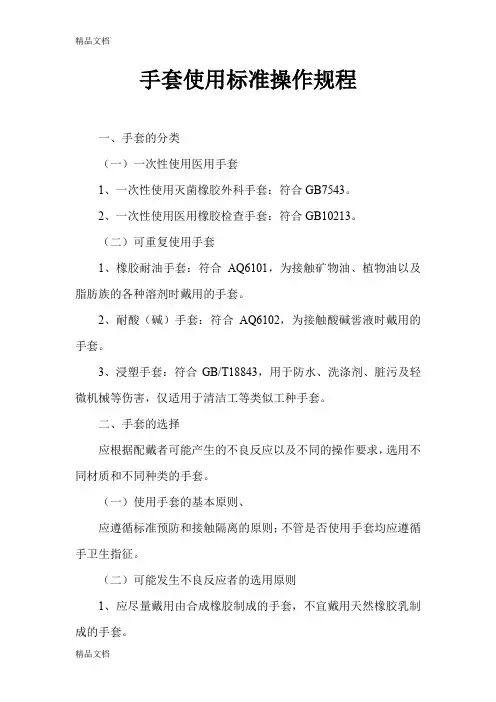
手套使用标准操作规程一、手套的分类(一)一次性使用医用手套1、一次性使用灭菌橡胶外科手套:符合GB7543。
2、一次性使用医用橡胶检查手套:符合GB10213。
(二)可重复使用手套1、橡胶耐油手套:符合AQ6101,为接触矿物油、植物油以及脂肪族的各种溶剂时戴用的手套。
2、耐酸(碱)手套:符合AQ6102,为接触酸碱喾液时戴用的手套。
3、浸塑手套:符合GB/T18843,用于防水、洗涤剂、脏污及轻微机械等伤害,仅适用于清洁工等类似工种手套。
二、手套的选择应根据配戴者可能产生的不良反应以及不同的操作要求,选用不同材质和不同种类的手套。
(一)使用手套的基本原则、应遵循标准预防和接触隔离的原则;不管是否使用手套均应遵循手卫生指征。
(二)可能发生不良反应者的选用原则1、应尽量戴用由合成橡胶制成的手套,不宜戴用天然橡胶乳制成的手套。
2、宜选用无粉手套,不宜选用有粉手套。
(三)一次性使用医用手套与可重复使用手套的使用原则1、直接接触患者,应使用一次性使用医用手套。
2、清洁环境或医疗设备,应使用一次性使用医用手套或可重复使用的手套。
3、一次性医用手套应一次性使用。
(四)外科手套的使用指征。
1、手术操作2、阴道分娩。
3、放射介入手术。
4、中心静脉置管。
5、全胃肠外营养和化疗药物准备。
(五)检查手套的使用指征接触患者的血液、休液、分泌物、排泄物及被体液明显污染的物品时,应使用检查手套。
1、直接接触:接触血液;接触黏膜组织和破损皮肤;有潜在高传染性、高危险性的微生物;疫情或紧急情况;静脉注射;抽血;静脉导管拔管;妇科检查;非密闭式吸痰。
2、间接接触:倾倒呕波士顿物;处理(清洁)器械;处理废物;清理喷溅的体液。
(六)无需使用手套的情况除接触隔离以外,不接触血液、体液或污染环境,不需要使用手套。
1、直接接触:量血压;测体温和脉搏;皮下和肌内注射;给患者洗澡和穿衣;转运患者;医治眼睛和耳朵(无分泌物);无渗血的静脉导管操作。
PVC手套分级标准
一、医疗级手套标准:手套表面无破洞,有粉手套粉量均匀,无明
显粉状;无粉手套无亮边、亮点;无黑点、无杂质,颜色呈透明乳白色,针孔率及物性标准均能符合客户要求。
二、工业级手套标准:
A级品:手套表面无破洞,有粉手套粉量均匀,无明显粉状;无粉手套无亮边,有轻微亮点,一盒内不能超过5只,轻微污点、小黑点直径≤1mm,不能超过3个;颜色呈透明乳白色,针孔率及物性标准均能符合客户要求。
B级品:手套表面无破洞(有粉手套粉量大),颜色发黄、发乌、变形,杂质严重,指甲印、指肚严重,克重低于(正常克重-0.25),拉力≤9mpa,伸长率≤245%。
针孔率≥50%。
废品:破洞、无卷唇、破边、扒破、划破、撕破、裂纹、粘破、余料、严重油污。
无菌橡胶医用手套产品技术要求瑞京一、物理性能要求1.强度和延展性:无菌橡胶医用手套应具有足够的强度和延展性,以确保在使用过程中不会破裂或穿刺。
手套的耐弯曲性能也应良好,以适应操作时的不同手势需求。
2. 厚度和重量:手套的厚度应适中,既要保证足够的防护能力,又要确保操作敏感度。
一般来说,手套的平均厚度应在0.08-0.2mm之间。
手套的重量应在合理范围内,过轻可能意味着材质不牢固,过重则可能影响操作的灵活性。
3.抗拉性能:无菌橡胶医用手套应具有良好的抗拉性能,能够承受一定拉力而不断裂或变形。
二、功能要求1.不漏气:手套应具备良好的密封性能,材质紧密,经过严密的工艺生产,以确保手套在使用时不会漏气,保持良好的防护效果。
2.不渗水:手套应具备防水功能,能够有效阻隔病原体、细菌和液体,在手术和医疗操作中提供可靠的防护。
3.不敏感:手套应采用无刺激性原材料制造,减少对用户的过敏反应,并配备适宜的手套内涂层,避免对皮肤造成刺激和损伤。
4.自适应:手套应采用弹性材料制成,能够自适应不同手型和手部动作,提供舒适的佩戴感受和使用体验。
5.防静电:手套应具备抗静电功能,以减少静电对操作的干扰,防止手套因静电产生火花或引起其他安全问题。
三、卫生要求1.无菌性:无菌橡胶医用手套应在出厂前通过有效的无菌检测,保证手套表面和内部没有细菌、病毒等病原体。
手套应采取适当的包装方式,保持无菌状态,以确保在使用时不会带入污染物。
2.清洁度:手套应通过严格的清洁工艺处理,表面应无明显污渍、杂质和异物。
3.合规性标识:手套应在外包装上标明产品合规性标识,包括产品名称、规格、批号、生产日期、生产厂家等信息。
同时,手套的外包装应做好防潮、防细菌污染等工作。
生效日期:2014年5月20日版本号: 1.0修改日期:页码: 1 / 3━━━━━━━━━━━━━━━━━━━━━━━━━━━━一、目的通过本制度,规范医务人员手套使用。
二、标准(一)手套分类1、一次性使用医用手套:包括一次性使用灭菌橡胶外科手套(简称无菌手套)和一次性使用医用橡胶检查手套(简称清洁或检查手套)。
2、可重复使用手套(1)橡胶耐油手套:符合AQ6101,为接触矿物质油、植物油以及脂肪族的各种溶剂时戴用的手套。
(2)耐酸(碱)手套:符合AQ6101,为接触酸碱溶液时戴用的手套(3)浸塑手套:符合GB/T18843,用于防水、洗涤剂、脏污及轻微机械等伤害,仅适用于清洁工等类似工种手套。
(二)手套使用原则1、应根据不同操作的需要,选择合适种类和规则的手套。
(1)接触患者的血液、体液、分泌物、排泄物、呕吐物及污染物品时,应戴清洁(检查)手套(2)进行手术等无菌操作、接触患者破损皮肤、黏膜时,应戴无菌手套。
2、一次性手套应一次性使用(三)各类手套使用指征1、下列情况应戴无菌手套:(1)手术操作(2)阴道分娩(3)放射介入手术(4)中心静脉置管(5)全胃肠外营养和静脉配置中心内配置药物时(6)无菌操作时(如留置导尿、闭式吸痰、骨穿、腰穿、伤口换药等)2、下列情况应戴清洁(检查)手套:━━━━━━━━━━━━━━━━━━━━━━━━━━━━(1)接触患者的血液、体液、分泌物、排泄物、呕吐物及污染物品时。
(2)接触潜在高传染性、高危险性的微生物时。
(3)接触实施接触隔离的病人和周围区域时(4)静脉注射时(5)静脉抽血(6)静脉导管拔管(7)妇科检查(8)吸痰(非闭式)(9)倾倒呕吐物(10)处理废物(11)清洗或清洁器械(12)清理血液、体液、呕吐物及污物时.(13)检验科、实验室在污染区操作及接触污染电脑时(四)戴手套与脱手套的指征1、戴手套指征:(1)进行无菌操作之前(2)接触血液或体液之前,不管是否进行无菌操作和接触破损皮肤和黏膜组织。
手套使用标准操作规程一、手套的分类(一)一次性使用医用手套1、一次性使用灭菌橡胶外科手套:符合GB7543。
2、一次性使用医用橡胶检查手套:符合GB10213。
(二)可重复使用手套1、橡胶耐油手套:符合AQ6101,为接触矿物油、植物油以及脂肪族的各种溶剂时戴用的手套。
2、耐酸(碱)手套:符合AQ6102,为接触酸碱喾液时戴用的手套。
3、浸塑手套:符合GB/T18843,用于防水、洗涤剂、脏污及轻微机械等伤害,仅适用于清洁工等类似工种手套。
二、手套的选择应根据配戴者可能产生的不良反应以及不同的操作要求,选用不同材质和不同种类的手套。
(一)使用手套的基本原则、应遵循标准预防和接触隔离的原则;不管是否使用手套均应遵循手卫生指征。
(二)可能发生不良反应者的选用原则1、应尽量戴用由合成橡胶制成的手套,不宜戴用天然橡胶乳制成的手套。
2、宜选用无粉手套,不宜选用有粉手套。
(三)一次性使用医用手套与可重复使用手套的使用原则1、直接接触患者,应使用一次性使用医用手套。
2、清洁环境或医疗设备,应使用一次性使用医用手套或可重复使用的手套。
3、一次性医用手套应一次性使用。
(四)外科手套的使用指征。
1、手术操作2、阴道分娩。
3、放射介入手术。
4、中心静脉置管。
5、全胃肠外营养和化疗药物准备。
(五)检查手套的使用指征接触患者的血液、休液、分泌物、排泄物及被体液明显污染的物品时,应使用检查手套。
1、直接接触:接触血液;接触黏膜组织和破损皮肤;有潜在高传染性、高危险性的微生物;疫情或紧急情况;静脉注射;抽血;静脉导管拔管;妇科检查;非密闭式吸痰。
2、间接接触:倾倒呕波士顿物;处理(清洁)器械;处理废物;清理喷溅的体液。
(六)无需使用手套的情况除接触隔离以外,不接触血液、体液或污染环境,不需要使用手套。
1、直接接触:量血压;测体温和脉搏;皮下和肌内注射;给患者洗澡和穿衣;转运患者;医治眼睛和耳朵(无分泌物);无渗血的静脉导管操作。
医用橡胶手套的渗漏与手卫生的相关性程飞;韩传平【期刊名称】《泰山医学院学报》【年(卷),期】2013(034)001【总页数】6页(P75-80)【关键词】医用手套;医院感染;手套渗漏;手套穿孔;洗手依从性【作者】程飞;韩传平【作者单位】泰山医学院附属医院,山东,泰安,271000;泰山医学院附属医院,山东,泰安,271000【正文语种】中文【中图分类】R608大量临床研究证实,有效预防控制感染的最简单、最经济的措施是手卫生,它能为医疗安全与服务质量提供保障,因此对手卫生已经引起全球的重视。
但作者发现医务人员对洗手的指证掌握不够,尤其戴手套操作完毕摘手套后几乎不洗手,不管戴手套实施的无菌操作还是污染操作,摘手套后医务人员目前普遍存在的误区,认为戴上无菌手套,手就不被污染,操作完毕摘掉手套后就视为手仍是干净的,所以摘手套后认为不用洗手。
事实上,手套的渗透性和手上常驻菌的移位已造成了手皮肤菌尘不同程度的污染,如果操作完毕摘手套后不洗手或不彻底洗手,仍然是直接导致医院感染的发生的重要途径和原因,为此作者就医用橡胶手套的渗漏与洗手依从性进行如下综述。
1 手卫生的研究正确的洗手是预防和控制病原体传播,降低医院感染发生的重要措施,对此引起全球的重视。
1985年美国疾病与预防控制中心发布了《洗手与医院环境控制指南》,1995年APIC(美国感染控制和流行病协会)发布了《医疗机构洗手与手消毒指南》,2002年10月CDC又发布了《医疗机构手部卫生指南》。
我国卫生部颁布的《手卫生规范》、《消毒技术规范》等对手部皮肤的清洁和消毒作了相关的介绍,已引起医务人员对手卫生重视,洗手的依从性不断提高。
我国手卫生规范的洗手指征为:l)接触病人前后,特别是在接触有破损的皮肤、黏膜和侵入性操作前后。
2)进行无菌技术操作前后,进入和离开隔离病房、ICU、母婴室、新生儿病房、烧伤病房、感染性疾病病房等重点部门时,戴口罩和穿脱隔离衣前后。
Designation:D3577–09Standard Specification forRubber Surgical Gloves1This standard is issued under thefixed designation D3577;the number immediately following the designation indicates the year of original adoption or,in the case of revision,the year of last revision.A number in parentheses indicates the year of last reapproval.A superscript epsilon(´)indicates an editorial change since the last revision or reapproval.This standard has been approved for use by agencies of the Department of Defense.1.Scope1.1This specification covers certain requirements for pack-aged sterile rubber surgical gloves used in conducting surgical procedures.1.2The values stated in SI units are to be regarded as standard.No other units of measurement are included in this standard.1.3The following safety hazards caveat pertains only to the test method portion,Section8,of this specification:This standard does not purport to address all of the safety concerns, if any,associated with its use.It is the responsibility of the user of this standard to establish appropriate safety and health practices and determine the applicability of regulatory limita-tions prior to use.2.Referenced Documents2.1ASTM Standards:2D412Test Methods for Vulcanized Rubber and Thermo-plastic Elastomers—TensionD573Test Method for Rubber—Deterioration in an Air OvenD3767Practice for Rubber—Measurement of Dimensions D5151Test Method for Detection of Holes in Medical GlovesD5712Test Method for Analysis of Aqueous Extractable Protein in Natural Rubber and Its Products Using the Modified Lowry MethodD6124Test Method for Residual Powder on Medical GlovesD6499Test Method for The Immunological Measurement of Antigenic Protein in Natural Rubber and its Products 2.2Other Documents:ISO2859Sampling Procedures and Tables for Inspection by Attributes3U.S.Pharmacopeia43.Classification3.1Type1—Gloves compounded primarily from natural rubber latex.3.2Type2—Gloves compounded from a rubber cement or from synthetic rubber latex.4.Materials and Manufacture4.1Any rubber polymer compound that permits the glove to meet the requirements of this specification.4.2A lubricant that meets the current requirements of the U.S.Pharmacopeia for Absorbable Dusting Powder may be applied to the glove.Other lubricants may be used if their safety and efficacy have been previously established.4.3The inside and outside surface of the rubber surgical gloves shall be free of talc.5.Significance and Use5.1The specification is intended as a reference to the performance and safety of rubber surgical gloves.The safe and proper use of rubber surgical gloves is beyond the scope of this specification.6.Sampling6.1For referee purposes,gloves shall be sampled and inspected in accordance with ISO2859.The inspection levels and acceptable quality levels(AQL)shall conform to those specified in Table1,or as agreed between the purchaser and the seller,if the latter is more comprehensive.7.Performance Requirements7.1Gloves,sampled in accordance with Section6,shall meet the following referee performance requirements:7.1.1Comply with requirements for sterility when tested in accordance with8.2.1This specification is under the jurisdiction of ASTM Committee D11on Rubber and is the direct responsibility of Subcommittee D11.40on Consumer Rubber Products.Current edition approved Jan.1,2009.Published February2009.Originally approved st previous edition approved in2006as D3577–06.2For referenced ASTM standards,visit the ASTM website,,orcontact ASTM Customer Service at service@.For Annual Book of ASTM Standards volume information,refer to the standard’s Document Summary page on the ASTM website.3Available from American National Standards Institute,25West43rd St.,4th Floor,New York,NY10036.4U.S.Pharmacopeia,latest edition,Mack Publishing Co.,Easton,PA19175.Copyright©ASTM International,100Barr Harbor Drive,PO Box C700,West Conshohocken,PA19428-2959,United States. --```,,,`,``,,`,,``````````,,,`-`-`,,`,,`,`,,`---7.1.2Be free from holes when tested in accordance with 8.3.7.1.3Have consistent physical dimensions in accordance with 8.4.7.1.4Have acceptable physical property characteristics in accordance with 8.5.7.1.5Have a powder residue limit of 2.0mg in accordance with 8.6.Have a recommended aqueous soluble protein content limit of 200µg/dm 2in accordance with 8.7and Annex A1or have a recommended antigenic protein content limit of 10µg/dm 2in accordance with 8.9and Annex A2.7.1.7Have a recommended maximum powder limit of 15mg/dm 2in accordance with 8.8.8.Referee Test Methods8.1The following tests shall be conducted to assure the requirements of Section 7as prescribed in Table 1:8.2Sterility Test —Testing for sterility shall be conducted in accordance with the latest edition of the U.S.Pharmacopeia .8.3Freedom from Holes —Testing for freedom from holes shall be conducted in accordance with Test Method D 5151.8.4Physical Dimensions Test :8.4.1The gloves shall comply with the dimension require-ments specified in Table 2.8.4.2The length shall be expressed in millimetres as mea-sured from the tip of the second finger to the outside edge of the cuff.8.4.3The width of the palm shall be expressed in millime-tres as measured at a level between the base of the index finger and the base of the thumb.Values of width per size other than listed shall meet the stated tolerance specified in Table 2.8.4.4The minimum thickness shall be expressed in milli-metres as specified in Table 2when using a dial micrometer described in Practice D 3767and in the locations indicated on Fig.1.For referee tests,cutting the glove is necessary to obtain single-thickness measurements.8.4.5Precision and Bias —The precision and bias of mea-suring glove dimensions are as specified in Practice D 3767.8.5Physical Requirements Test :8.5.1Before and after accelerated aging,the gloves shall conform to the physical requirements specified in Table 3.Tests shall be conducted in accordance with Test Methods D 412.8.5.2Accelerated aging tests shall be conducted in accor-dance with Test Method D 573.Test the gloves by either one of the following methods:8.5.2.1After being subjected to a temperature of 7062°C for 16662h,the tensile strength and ultimate elongation shall not be less than the values specified in Table 3.This method shall be the condition for referee tests.8.5.2.2After being subjected to a temperature of 10062°C for 2260.3h,the tensile strength and ultimate elongation shall not be less than the values specified in Table 3.8.5.3Precision and Bias —The precision and bias of deter-mining tensile strength and ultimate elongation of gloves are as specified in Test Methods D 412.8.6Powder Free Gloves :8.6.1Determine the powder residue using Test Method D 6124.8.7Aqueous Extractable Protein Content :8.7.1Determine the aqueous extractable protein (µg/mL)using Test Method D 5712for each glove sample tested.8.7.2Determine the total µg of aqueous extractable protein in each glove sample by multiplying the result from 8.7.1by the total volume of extractant used for that specific glove sample.If the glove sample is less than a whole glove,then adjust the protein results to reflect the amount of protein in the whole glove.8.7.3Determine the square decimetres for the glove size.Multiply the minimum length and nominal width found in Table 2and convert to dm 2using (dm 2/mm 2)(mm 2/10000).Four (4)is the factor for all inside and outside surface areas.8.7.4Determine the aqueous extractable protein content of a glove sample by dividing the result from 8.7.2(total µg of protein)by 8.7.3(total surface area of glove).TABLE 1Performance RequirementsCharacteristic Related Defects Inspection LevelAQL Sterilityfails sterility AN/A Freedom from holes holesI 1.5Physical dimensions length,width,and thicknessS-2 4.0Physical properties before aging,after accel-erated agingS-2 4.0Powder Free Residue Exceeds Maximum Limit N=5N/A Protein Content Exceeds Recommended Maximum LimitN=3N/A Powder Amount Exceeds Recommended Maximum LimitN=2N/A Antigenic Protein ContentExceeds Recommended Maximum LimitN=1N/AASee U.S.Pharmacopeia .TABLE 2Dimensions and TolerancesDesignation SizeTolerance 51⁄2661⁄2771⁄2881⁄29Length,mm 245265265265265265265265min Width,mm 707683899510210811466Thickness,mm:Finger 0.10min Palm 0.10min Cuff0.10min--```,,,`,``,,`,,``````````,,,`-`-`,,`,,`,`,,`---8.7.5If the sample is more than one (1)glove,use theaverage µg/dm 2of protein for the number of gloves tested in the sample.8.8Powdered Gloves :8.8.1Determine the recommended maximum powder limit using Test Method D 6124for powdered gloves.8.8.2Determine the square decimeters for the glove size as in 8.7.3.8.9Antigenic Protein Content :8.9.1Determine the extractable antigenic protein (µg/mL)using Test Method D 6499for each glove sample tested.8.9.2Determine the total microgram of extractable anti-genic protein in each glove sample by multiplying the result from 8.9.1by the total volume of extractant used for that specific glove sample.8.9.3Determine the square decimeter for the glove size as in 8.7.3.8.9.4Determine the extractable antigenic protein content of a glove sample by dividing the result from 8.9.2(total microgram of antigenic protein)by 8.9.3(total surface area of glove).9.Acceptance9.1Gloves will be considered to meet the referee perfor-mance requirements when test results conform to the require-ments prescribed in Table 1.9.2Retests or reinspections are permissible under the pro-visions of the U.S.Pharmacopeia and ISO 2859.10.Packaging and Package Marking10.1Packaging —Packaging shall be provided to maintain sterility after sterilization during shipping and storage and permit opening without contamination of the gloves.10.2Marking:FIG.1Location of Thickness MeasurementsTABLE 3Physical RequirementsType Before Aging After Accelerated AgingTensile Strength Ultimate Elongation Stress at 500%Elongation Tensile Strength Ultimate Elongation I 24MPa,min 750%min 5.5MPa,max 18MPa,min 560%min II17MPa,min650%min7.0MPa,max12MPa,min490%min--```,,,`,``,,`,,``````````,,,`-`-`,,`,,`,`,,`---10.2.1Gloves shall have an appropriate marking or be color-coded to designate size.10.2.2Inner wrappers or wallets,if used,shall bear a size marking to be located on the outside of the wallet or wrapper.10.2.3Packages shall bear markings for the contents to include the glove size,instructions for opening,the legend “sterile,”and a manufacturing lot number.10.2.4The outermost case shall be labeled on one or more end panels with the glove size,the legend“sterile,”and a manufacturing lot number.10.2.5All levels of packaging shall conform to all appro-priate government labeling regulations.11.Keywords11.1gloves;rubber;surgicalANNEXES (Mandatory Information) A1.PROTEIN CONTENTA1.1The current assay precision is large enough that only a recommended limit can be considered.A1.2Consideration should be given to the relative repeat-ability and reproducibility when reporting test method results.A1.3Reasonable allowance should be given for test results in excess of the recommended limit until greater precision of the method can be attained.A2.ANTIGENIC PROTEIN CONTENTA2.1The current assay precision is large enough that only a recommended limit can be considered.A2.2Consideration should be given to the relative repeat-ability and reproducibility when reporting test method results.A2.3A pooled sample from three individual NR specimens or products as extracted in Test Method D5712is permitted for use as the extraction sample.ASTM International takes no position respecting the validity of any patent rights asserted in connection with any item mentioned in this ers of this standard are expressly advised that determination of the validity of any such patent rights,and the risk of infringement of such rights,are entirely their own responsibility.This standard is subject to revision at any time by the responsible technical committee and must be reviewed everyfive years and if not revised,either reapproved or withdrawn.Your comments are invited either for revision of this standard or for additional standards and should be addressed to ASTM International Headquarters.Your comments will receive careful consideration at a meeting of the responsible technical committee,which you may attend.If you feel that your comments have not received a fair hearing you should make your views known to the ASTM Committee on Standards,at the address shown below.This standard is copyrighted by ASTM International,100Barr Harbor Drive,PO Box C700,West Conshohocken,PA19428-2959, United States.Individual reprints(single or multiple copies)of this standard may be obtained by contacting ASTM at the above address or at610-832-9585(phone),610-832-9555(fax),or service@(e-mail);or through the ASTM website().--```,,,`,``,,`,,``````````,,,`-`-`,,`,,`,`,,`---。